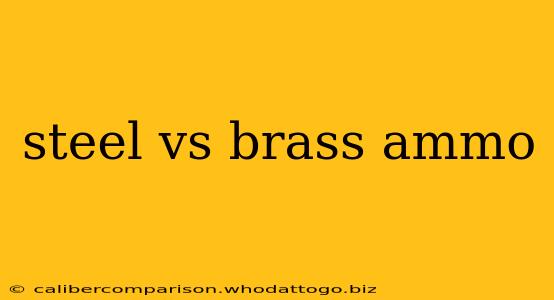Choosing the right ammunition is crucial for any shooter, whether you're a seasoned pro or just starting out. Two of the most common casing materials are steel and brass, each with its own distinct advantages and disadvantages. This comprehensive guide will delve into the key differences between steel and brass ammo, helping you make an informed decision for your specific needs.
Steel Ammo: The Budget-Friendly Choice
Steel-cased ammunition has gained significant popularity due to its affordability. This lower price point stems from the lower cost of steel production compared to brass. This makes it an attractive option for high-volume shooters, particularly those engaged in practice or plinking.
Advantages of Steel Ammo:
- Cost-Effective: The most significant advantage is the lower price per round, allowing for more practice time on the range without breaking the bank.
- Abundant Availability: Steel-cased ammo is generally readily available, even during periods of ammunition shortages.
Disadvantages of Steel Ammo:
- Potential for Gun Damage: Steel cases are harder than brass and can potentially damage firearm components, particularly in semi-automatic pistols and rifles. This is especially true with high-pressure loads. The increased hardness can lead to accelerated wear on the extractor, ejector, and feed ramp.
- Reduced Accuracy: While advancements have been made, some shooters report reduced accuracy with steel-cased ammunition compared to brass. This can be attributed to variations in case dimensions and potentially less consistent manufacturing processes.
- Not Suitable for All Firearms: Many firearm manufacturers explicitly warn against using steel-cased ammo in their weapons. Always check your firearm's owner's manual before using steel ammo.
- Environmental Concerns: The zinc coating often found on steel cases can be environmentally problematic if disposed of improperly.
- Magnetic Properties: The magnetic nature of steel cases can interfere with certain reloading processes and may be unsuitable for use in some firearm types.
Brass Ammo: The Premium Performer
Brass ammunition has long been the standard in the shooting world, prized for its reliability and performance. While more expensive, brass offers several key advantages that justify the price for many shooters.
Advantages of Brass Ammo:
- Superior Reliability: Brass cases are more consistent in dimensions, leading to reliable feeding and ejection. They are also more resilient to damage.
- Increased Accuracy: The consistency of brass cases often contributes to improved accuracy compared to steel.
- Re-loadable: Brass cases can be reloaded multiple times, significantly reducing the long-term cost of shooting. This is a key factor for serious shooters and reloaders.
- Generally Compatible: Brass ammo is widely compatible with most firearms, providing greater versatility.
- Environmentally Friendly: Brass is readily recyclable, making it a more environmentally responsible choice compared to steel.
Disadvantages of Brass Ammo:
- Higher Cost: The most significant drawback is the higher price per round compared to steel ammunition.
Steel vs. Brass: The Verdict
The choice between steel and brass ammunition ultimately depends on your priorities and shooting needs. Steel ammo offers a budget-friendly option for high-volume practice, while brass provides superior reliability, accuracy, and reusability. Always consult your firearm's manual to ensure compatibility and prioritize safety when making your choice. If budget is your primary concern, steel may suffice for casual shooting, but for serious competitive shooting or hunting, brass is generally the preferred choice. Understanding these key differences will allow you to make an informed decision that optimizes your shooting experience and ensures the longevity of your firearms.

